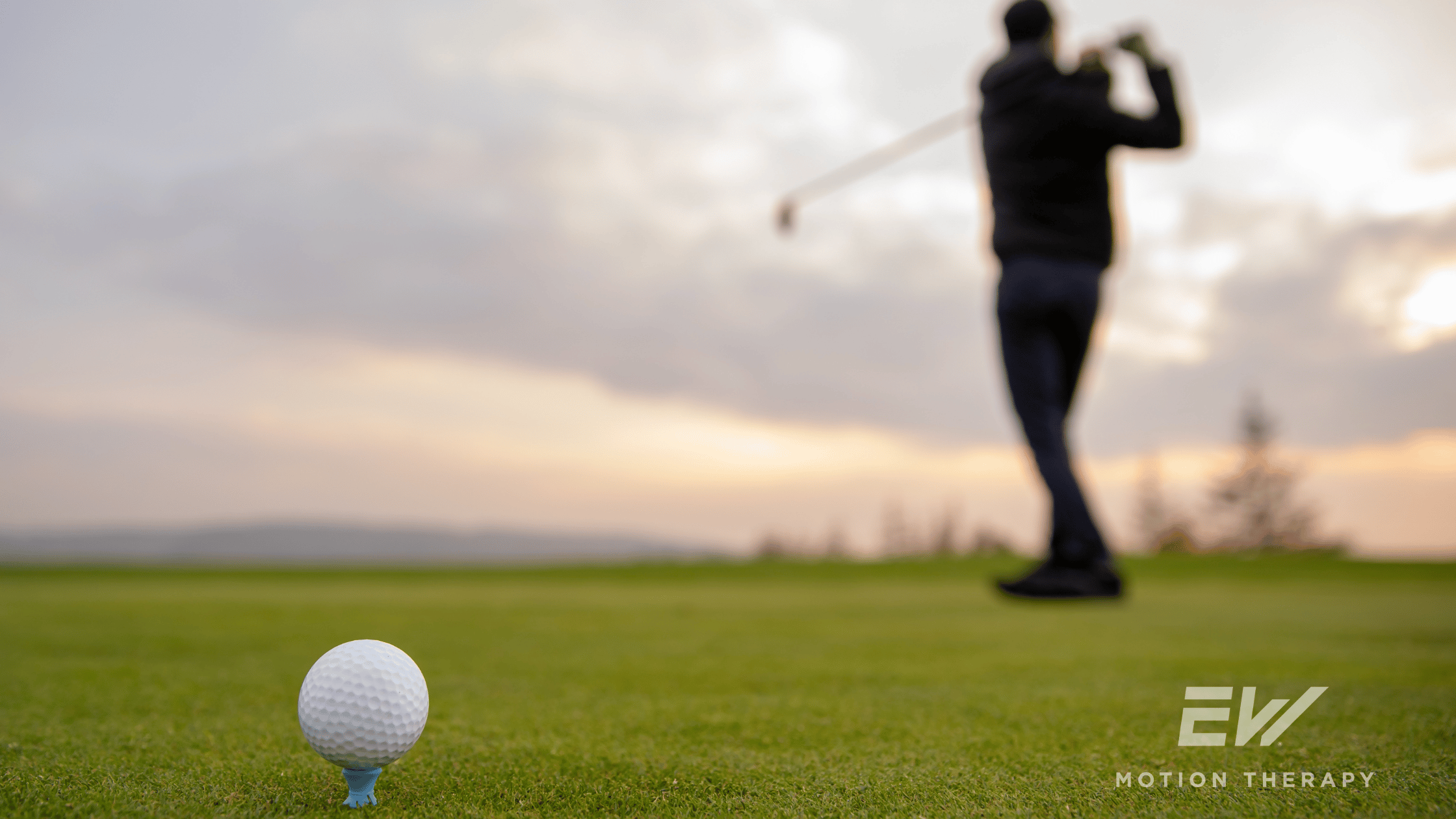The Importance of Strength Training for Golfers: Enhancing Your Game and Reducing Injury Risk

Physical Therapist, PT, DPT // EW Motion Therapy Meadowbrook
Golf might appear as a relaxed sport to the untrained eye, but it demands much more than a good swing technique. Strength training is crucial for golfers of all skill levels to enhance performance and prevent injuries. We love helping our golfers at EW Motion Therapy build strength to improve their performance and continue playing the game they love. You may decide that our golf program isn’t right for you, but you can still read this article as we explore where golfers should build strength, how strength training can improve their game, and how physical therapy plays a pivotal role in this process.
Why golfers need strength training
Building a foundation for a powerful swing
Golfers rely heavily on their swing to drive the ball long distances. A powerful swing is built on the foundation of strong, flexible muscles. Strength training enhances muscle power and endurance, allowing golfers to hit the ball more precisely. Moreover, strengthening the muscles helps maintain balance and stability during the swing, vital for achieving consistency in play.
Preventing common golf injuries
Golf is unique in its use of almost every muscle group, and the repetitive nature of swings can lead to overuse injuries. Common areas affected include the back, shoulders, elbows, and wrists. Strength training enhances performance and significantly reduces the risk of injuries in these areas and throughout the body. By preparing the body to handle the stresses of repeated swings, golfers can enjoy more time on the course and less time recovering.
Key muscle groups to focus on
Core stability for better swing dynamics
The core muscles—spanning the abdomen, lower back, hips, and pelvis—are fundamental in golf. A strong core allows for better rotation and control during the swing, contributing to increased swing speed and force. Exercises like planks, Russian twists, and medicine ball throws can be particularly effective in building a resilient core.
Lower body strength for endurance and power
The power of a golf swing starts from the ground up. Strengthening the legs and glutes can improve stability and power transfer through the swing. Squats, lunges, and leg presses build muscle and enhance joint stability, reducing the likelihood of knee and ankle injuries. For golfers, endurance in these muscle groups also means less fatigue toward the end of a round, maintaining consistent performance throughout.
Upper body and shoulders for enhanced control
While the lower body initiates the power in a swing, the upper body, including the chest, back, and shoulders, controls and directs this power. Exercises like overhead presses, pull-ups, and rowing enhance shoulder stability and strength, which are essential for controlling the golf club through the swing path. Strong upper body muscles help maintain posture and alignment, critical aspects of a skilled golfer's technique.
How strength training improves game performance
Increased swing speed and distance
Strength training directly correlates to increased muscular strength and explosive power, which is essential for increasing swing speed. A faster swing speed translates into greater impact on the ball, thereby increasing its distance. Regular strength training can help golfers improve how far they hit the ball, an essential aspect of competitive golfing.
Enhanced endurance and concentration
Golf rounds are long, often taking several hours and requiring sustained concentration and physical effort. Strength training improves overall stamina, allowing golfers to maintain peak performance for longer. This enhanced endurance helps maintain a high level of play and concentration, which is crucial during the final holes of a round.
How physical therapy helps golfers strength train
Tailored exercise regimens
Physical therapists are instrumental in designing personalized strength training programs addressing a golfer’s needs. They focus on improving strength in areas that will most benefit their game. They can assess individual weaknesses and imbalances, creating a balanced workout that enhances strengths and addresses vulnerabilities. Here are a few exercises one of our golf specialists might assign to help a golfer build strength.
Supine bridge: Begin lying on your back with your arms resting at your sides, your legs bent at the knees, and your feet flat on the ground. Tighten your abdominals and slowly lift your hips off the floor into a bridge position, keeping your back straight. Make sure to keep your trunk stiff throughout the exercise and your arms flat on the floor.

Split squats: Begin standing. Step forward with one leg, keeping your feet hip-width apart. Keep your trunk upright with your ears, shoulders, and hips aligned. Lower your body straight down, using the front leg to do most of the work. Return to the upright split stance position and repeat. Keep your trunk upright, and you should feel this exercise on the outside of your thigh.

Standing bent over a single-arm scapular row with table support: Begin standing near a table with your trunk bent forward and one arm resting for support. Your other arm should be hanging toward the ground. Bend your arm, pulling your elbow upward, then lower it back down and repeat, making a sawing motion. Make sure to keep your back straight during the exercise, and do not shrug your shoulder.

Russian twists: Begin sitting on the ground with your hips and knees slightly bent, ankles dorsiflexed, and heels on the ground. Your trunk should be leaned backward, and your spine should be neutral. Twist from side to side. Maintain a neutral spine position while twisting from side to side.

Injury rehabilitation and prevention
Physical therapists are crucial in helping golfers recover from injuries and prevent them. They can teach proper techniques and exercises that reduce the risk of common golf injuries. By incorporating flexibility and mobility workouts into a golfer’s regimen, physical therapists ensure that the body remains agile and well-prepared for the demands of golf.
Ongoing support and education
Physical therapy provides ongoing support, adjustments to exercise routines, and education on best practices for both in-gym workouts and on-course play. This educational aspect helps golfers understand their bodies better and make informed decisions about their training and health.
For golfers, strength training is not just an add-on to their practice routine but an essential element of their overall athletic development and injury prevention strategy. Golfers can significantly improve their game and endurance by focusing on core, lower body, and upper body strength. Physical therapy is crucial in ensuring strength training is effective, safe, and tailored to the golfer's needs. As golfers incorporate these practices into their routine, they will find themselves hitting farther, playing longer, and enjoying the game more than ever. We love helping our golfers at EW Motion Therapy continue playing the game they love for a long time. If you want to learn more about how physical therapy can help your golf career, click the button below to download our answers to 20 frequently asked questions.


